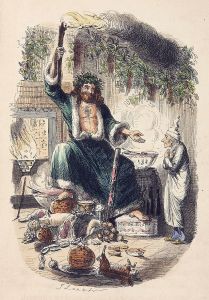
A few weeks ago I was trying to sort out the blogging rota. As the MusiCB3 bloggers headed off for their Christmas breaks I was left with the Yuletide blog that will take us into the New Year. I thought I knew exactly what I was going to blog about – something festive, perhaps traditional Christmas music in East Anglia? You’d think it would be easy – after all there were plenty of collections of traditional folksongs dating from Victorian times into the twentieth century, but to my growing frustration I discovered that most of the collections came from the west of England. There seemed to be nothing from the east…
And then purely by chance I found J.A. Fuller-Maitland’s English carols of the fifteenth century. These aren’t just any carols, they are one of the earliest and best sources of English carols, and (it gets better) they are from a manuscript in Trinity College, Cambridge (O.3.58). The roll was copied in the first half of the fifteenth century, and comes almost certainly from Norfolk. I had found my East Anglian Christmas.
The parchment roll consists of three sections sewn together into a scroll that stretches just over 6 feet. The 13 “carols” were copied by a single scribe, and some of the words have a distinctive Norfolk twang, suggesting that they were sourced from somewhere within the county. The roll is exciting for several reasons; as well as being one of the earliest sources of English carols, it also contains the earliest copy of The Agincourt Song pre-dating the Bodleian’s manuscript by some years.
Of the remaining “carols” one is for St. Stephen’s (“Boxing”) Day, a few related to the Virgin Mary could be sung throughout the year (the tradition of Marian devotion was particularly strong in medieval England), while some have a distinctive festive feel. Trinity College’s Library has recently blogged about the roll and mentions recent recordings that have been made of the medieval songs. What intrigued me though, when looking at the contents list, is how many of these songs have been re-set in the twentieth century giving new listeners a renewed appreciation of these medieval lyrics.
Among these carols is As I lay upon a night, recently set by Jamie W. Hall.
While Cecilia McDowall makes use of drones and dance-like rhythms in her setting of Now may we singen producing a work that manages to be both medieval and unmistakably contemporary. For more information on Cecili
Compare that with this setting of the same work as it may have been performed when the Trinity roll was freshly inked.
More rarely set is Be merry, be merry, I pray you. This setting, by Stephen Cleobury, was originally commissioned by the Worshipful Company of Musicians’ for their annual carol service, but has since been featured a number of times in King’s annual Nine Lessons and Carols service on Christmas Eve.
There have also been a few settings of the tenth carol in the roll What tidings bringest thou, messenger? Including this arrangement, part of Stephen Main’s Christmas cantata, Wonder tidings.
The final carol There is no rose is probably the best known of all the carols, and the most widely re-set. Surprisingly, the version that is probably most faithful to the Trinity original, has been recorded recently by Sting. Its most famous contemporary setting was included in Benjamin Britten’s in A ceremony of carols.
Written by Margaret Jones, first published on MusiCB3 Christmas 2014.